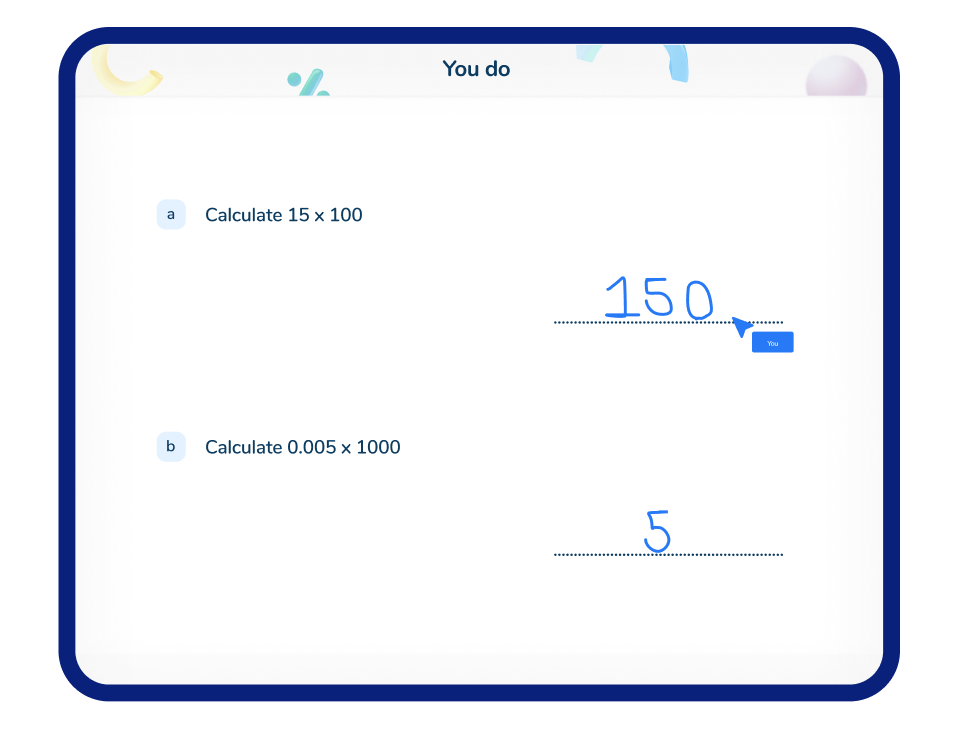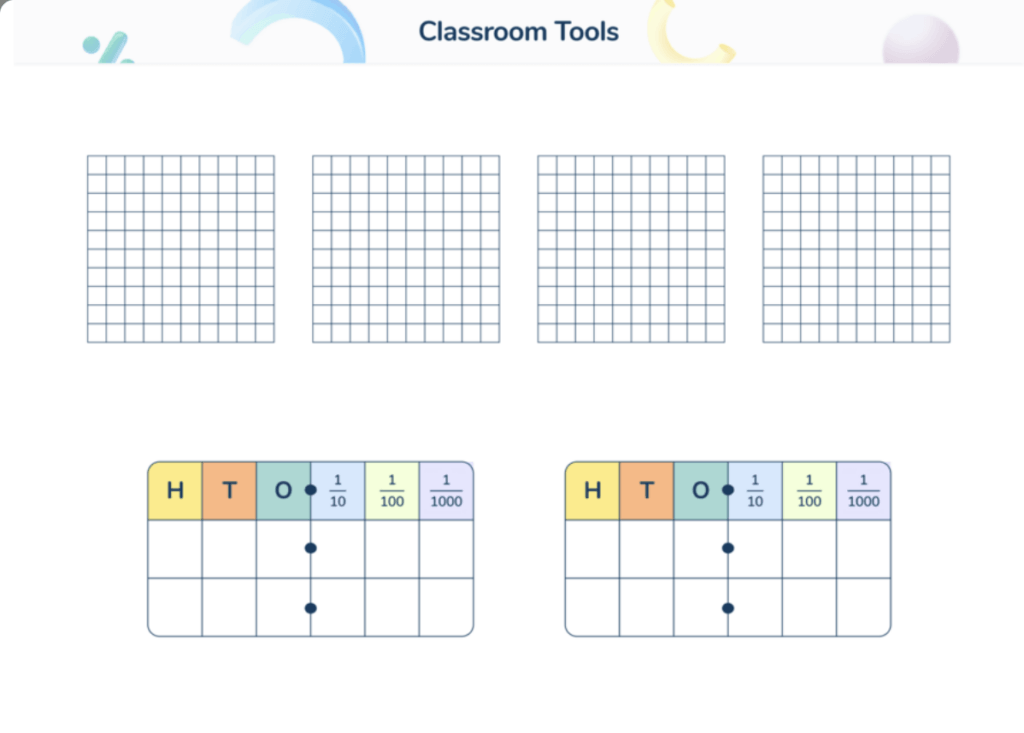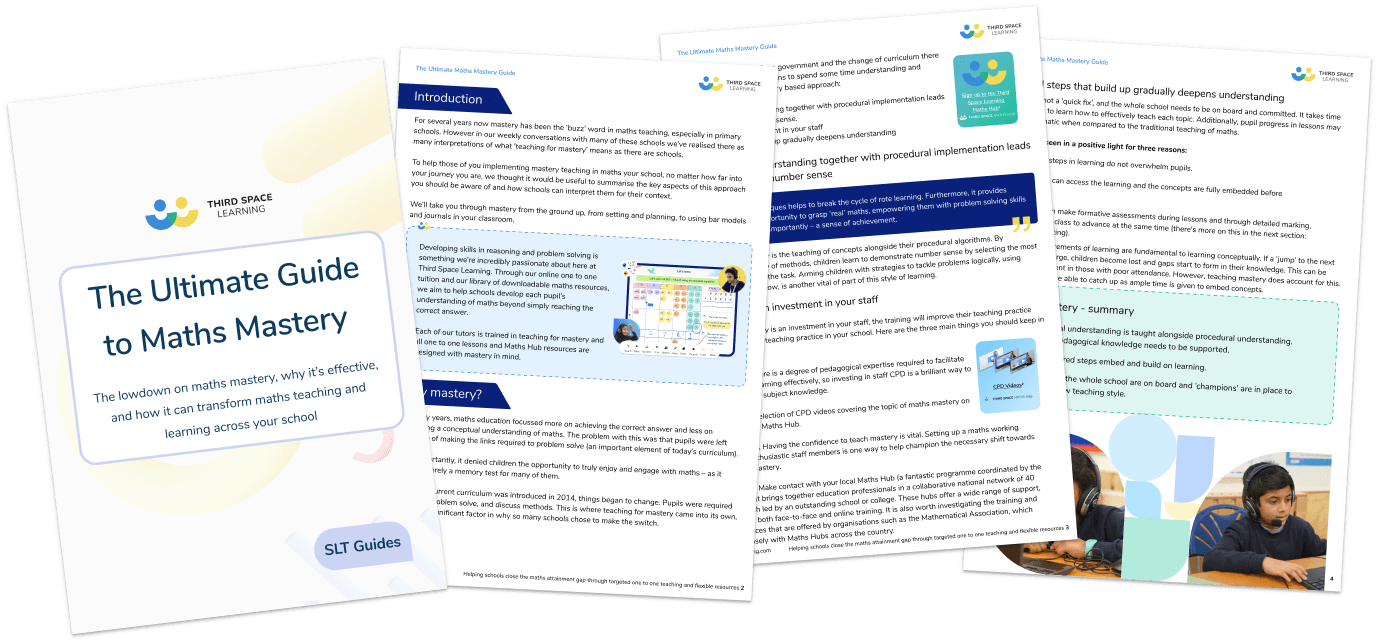I Do We Do You Do: How To Introduce New Learning Effectively
I do, we do, you do is an effective model of teaching, also known as ‘gradual release of responsibility’ for introducing new concepts and skills to learners. This scaffolding strategy is effective across all subjects in primary and secondary classrooms.
In this article, our expert author Zoe Benjamin discusses the benefits of this approach and provides practical steps for implementing it in your classroom, using examples from the Third Space Learning curriculum.
What is I do we do you do?
I do, we do, you do is an effective teaching strategy designed to deliver new content to students in a structured and supportive manner. Also known as the gradual release of responsibility model, the approach transitions students from having no prior knowledge of a topic to completing independent work and problem-solving activities using their new learning.
It is a versatile tool that is equally successful for teaching students to conduct experiments in science to making comparisons between poems in English. It is particularly effective for teaching maths as it scaffolds students learning when needed, with the ultimate goal of independent practice.

The I do, we do, you do method is central to the Third Space Learning maths tutoring curriculum from KS2 through to GCSE. Below, we guide you step-by-step through the approach with practical examples from both our KS2 and KS3 lessons.
The Ultimate Guide To Maths Mastery
All you need to know to successfully implement a mastery approach to mathematics in your primary school, at whatever stage of your journey
Download Free Now!I do: the modelling stage
During the ‘I do’ stage, the teacher models the new skill step by step through worked examples and thinking aloud to help learners internalise processes. Teachers can use tools like PowerPoint, a visualiser or writing directly on the whiteboard to share their work. Usually, teachers use direct instruction or explicit instruction as students’ initial level of understanding is typically low.
The aim here is to avoid cognitive overload. You may wish to model worked examples without a verbal explanation first so students can focus on the process. Ensure there is plenty of opportunity for students to discuss what they see and ask questions.
For example, when introducing long division, the teacher may model several long division examples on the whiteboard in silence before verbally explaining each step.

In Third Space Learning’s one to one online maths tutoring sessions for KS2-KS3, tutors guide students through a problem using the interactive classroom. This is the ‘Follow Me’ stage, where tutors break down new skills and concepts into manageable steps, providing verbal explanations to reduce cognitive load before moving on to the ‘we do’ stage.
We do: the facilitation stage
The ‘we do’ stage, also called the facilitation stage involves students working with their teacher or in small groups to begin practising the new skill. This stage is most effective when the guided practice closely mimics the teacher’s modelled work.
Teachers may provide scaffolding at this stage, such as a writing frame or partially completed worked examples, and gradually remove this scaffolding as learners become more proficient. Scaffolding may depend on the complexity of the task. Teachers must continue to provide feedback during the we do stage and check students’ understanding. Where necessary, teachers should re-model and explain the task and processes.
For example, you may now complete a long division example as a class, discussing the process step by step. Alternatively, students may complete a long division problem in a small group or pairs taking it in turns to explain each step to the rest of the group. Or, students may complete a partially completed long division worked example. Upon completion and identification of any misconceptions, re-model or explain the process as needed.

In a Third Space Learning lesson, students complete a question with their tutor’s support, called ‘Your turn’. The worked example remains on the same screen for students to refer to as they work with their tutor to complete the new example.
Through effective questioning, tutors can conduct formative assessments, identify and address any misconceptions and reteach where necessary. Third Space Learning lessons include support slides for students who need them and allow tutors to personalise the learning and pace to each student’s needs.
You do: the independent stage
In the ‘you do’ stage, students begin independent practice. While some students may still require additional support through questioning, sentence stems or concrete maths resources, most will be ready to complete questions independently. Students can use the worked examples, prompt sheet or written instructions from the ‘I do’ and ‘we do’ stages as references.
Chunking independent practice means students avoid repetitive mistakes. Those who are making mistakes can return to the we do facilitation stage.
For example, students now complete a series of long division questions independently. Students complete four or five questions and then use an answer sheet to peer or self-mark. This helps students identify whether they need to ask for help or refer back to the scaffolds for support.


When students are ready, Third Space Learning tutors will gradually remove scaffolding to guide students to more independent practice. This stage is ‘You do’. The type and amount of support provided is personalised to student needs – from carefully planned questioning and prompts to visual models. This in-built flexibility ensures that the level of work offers all students the optimal desirable difficulty.


Third Space Learning’s GCSE revision programme provides students with many opportunities for guided practice to consolidate learning and prepare for exams. As a revision programme, the format of the lesson differs from our KS2 and KS3 programmes. However, we continue to draw on the insights and benefits of the I do, we do, you do approach. Carefully planned lessons build on skills and understanding. Complex questions are broken down into small steps and scaffolding and support with personalised support for students’ individual needs.
The benefits of I do we do you do
The I do, we do, you do approach offers many benefits to learners that enhance engagement and improve academic outcomes.

The following benefits all contribute to the success of the I do, we do, you do approach:
1. Reduced cognitive load
Modelling and scaffolding new skills minimises the pressure on students’ working memory, avoiding cognitive overload. At each stage of the learning process, students can master one element of the new skill at a time before moving on to the next.
2. Gradual release of responsibility
The I do, we do, you do approach gradually moves learning from the teacher’s responsibility to the student’s responsibility. The gradual release model, developed through social studies research, emphasises the importance of collaboration during the ‘we do’ stage and direct instruction during the ‘I do’ stage.
3. Provides a point of reference
Model answers from the ‘I do’ stage provide students with a useful resource to refer back to in the future. This helps learners to work independently and with autonomy.
4. Immediate feedback
Guided practice offers immediate feedback. This feedback helps students to monitor their progress, an important element of metacognition which supports independent learning. Use guided practice as a formative assessment to provide teachers with immediate feedback about their student’s level of understanding. This allows them to adjust their teaching methods during the lesson to improve learning.
Applying I do we do you do to classroom practice
When applying the I do, we do, you do approach to the classroom, it is important to plan carefully and to acquire the necessary subject-specific pedagogy to model to students. The key is to break new knowledge down into bite-sized chunks of information.
Here are practical tips for planning and delivering the I do, we do, you do approach in your classroom:
Planning tips
- Plan questions, examples and tasks in advance and order them in increasing difficulty.
- Present New material in small bite-sized steps.
- Identify common misconceptions associated with the topic studied to inform the questions and examples shared with students.
Delivery tips
- Model in silence first allowing students to pay full attention to each step.
- Use direct instruction and verbalize thought processes.
- Allow students time to process model answers.
- Provide scaffolded problems during guided practice and encourage peer collaboration.
- Obtain feedback at each stage; students only progress once they have mastered the current stage.
- Present real-world contexts and problem-solving questions during the ‘you do’ stage.

Pedagogy experts and qualified teachers with decades of experience working in UK schools design the Third Space Learning lessons. Every lesson is accompanied with clear, detailed tutor notes which detail the most effective prompts and questions to ask students at each stage. It also includes common misconceptions and advice for tutors delivering the session.

Once students are secure in their understanding of a Third Space Learning lesson, they practise the new skill in a novel context or problem-solving context in the ‘Go further’ stage. This ensures all students are appropriately stretched and challenged according to their ability and encouraged to develop critical thinking skills.
I do we do you do and Rosenshine’s principles of instruction
The I do, we do, you do approach aligns closely with many popular pedagogical methods, including Rosenshine’s principles of instruction, making it highly effective for improving learning outcomes.
In 2020, Tom Sherrington organised these principles into four categories, which provide a useful framework to examine the links with I do, we do, you do:
- Sequence concepts and modelling: present new material in small steps with models and scaffolding.
- Questioning: use guided practice to ask questions and provide immediate feedback.
- Stages of practice: include guided and independent practice to ensure a high success rate.
- Review material: offer opportunities to review prior learning regularly.
1. Sequence concepts and modelling
This is the foundation upon which the I do, we do, you do approach is based. Within this category, Rosenshine recommends presenting new material using small steps. Students should receive models, examples, and scaffolding for difficult tasks. This occurs during both the ‘I do’ and ‘we do’ stages as teachers model examples and provide guided practice.
2. Questioning
This category refers to the importance of asking lots of questions to check students’ understanding. This occurs during the ‘we do’ stage through guided practice. To get the full benefit from this, there needs to be immediate feedback and the questions need to be part of an ongoing process of formative assessment.
3. Stages of practice
Within this category, Rosenshine promotes the use of guided practice, independent practice, and designing tasks so that students achieve a high success rate. The I do, we do, you do approach helps students to experience success at every stage. The gradual release of responsibility helps students to continue being successful throughout the guided practice (we do) and independent practice (you do).
4. Reviewing material
This final category recommends that students have opportunities to review prior learning on a daily, weekly, and monthly basis. Once the new pupils learn new knowledge through I do, we do, you do, this principle of instruction begins.
The I do, we do, you do teaching strategy is equally effective in primary and secondary schools and across all subjects. It improves learning by gradually releasing responsibility from the teacher to the student which minimises cognitive load and allows learners to experience continuous success.
I do, we do, you do FAQ
No FAQs available at the moment.
DO YOU HAVE STUDENTS WHO NEED MORE SUPPORT IN MATHS?
Every week Third Space Learning’s specialist school tutors support thousands of students across hundreds of schools with weekly online 1 to 1 maths lessons designed to plug gaps and boost progress.
Since 2013 these personalised one to 1 lessons have helped over 150,000 primary and secondary students become more confident, able mathematicians.
Learn how tutors build rapport or request a personalised quote for your school to speak to us about your school’s needs and how we can help.





